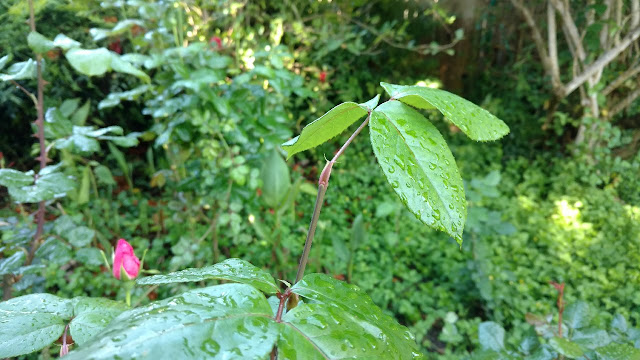
|
|
This is a blind shoot on Gentle Giant, a hybrid tea rose. Weather fluctuations confuse plants, causing blind shoots in roses, among other examples of odd behavior. (Photo: Debbie Arrington)
|
Have you noticed your plants behaving oddly? It could be the weather.
So far this month, Sacramento high temperatures have jumped around wildly. According to the National Weather Service, we saw more than a 30-degree swing in just eight days. Memorial Day, the mercury hit 105 degrees. On June 8, the high reached only 74.
Wednesday was even cooler with a high of just 73 degrees. That's 15 degrees below average for this week.
Dramatic temperature fluctuations can confuse plants, especially in spring. This is when warm-season vegetables are growing rapidly, blooming and setting their first fruit.
Sudden drops or increases in temperature can cause plants to drop flowers or fruit. Tomatoes especially can see their pollination affected, refusing to set when temperatures top 95 – but growing much more slowly when temperatures fall.
Roller-coaster highs affect roses, too. These hot-cold flip-flops tend to produce “blind shoots,” growth that never produces a flower.
The stems look healthy with lots of foliage and fast growth. But no matter how long those stems grow, they won’t sprout a bloom.
Blind shoots are the result of extreme fluctuations in temperature and growing conditions. Our yo-yo June weather confused some bushes, especially when temperatures plunged back below normal.
Another oddity: Blind shoots can appear on the same bush with normal blooming stems.
Some rose varieties are more sensitive to temperature fluctuations than others. But right now in my own rose garden, at least 20 bushes have blind shoots, including usually reliable Olympiad, a red hybrid tea, and Frida Kahlo, a multicolor floribunda.
The cure for blind shoots: Prune them off. Restart the growth by cutting the cane or shoot back about 5 or 6 inches, snipping about 1/2 inch above a leaf with five leaflets.
Lower temperatures with highs in the 70s or low 80s will bring back another scourge: Powdery mildew. Triple-digit heat can stop outbreaks of that fungal disease, which attacks a wide range of plants (especially roses, bougainvillea and lilacs). But it can survive on fallen foliage or mulch. When the temperature’s right (like it is right now), those spores seem to jump back to life.
Keep an eye on plants and remove any foliage showing signs of powdery mildew, which can appear like a dusting of powdered sugar. If possible, quarantine infected plants in containers by distancing them from other plants. (Think of it as social distancing for your potted plants.)
Rust, black spot and other fungal disease can grow rapidly now, too. If working in the garden, sanitize pruning tools often by wiping the blades with a Clorox wipe or similar product. It will cut down on the spread of infection.
Breezy conditions can dry out newly planted vegetables or top soil. Check your soil moisture to make sure new seedlings are getting enough water.
Watch out for weeds and invasive insects! They love this cooler weather, too.
This cooldown is only temporary. Things soon will be back to feeling like summer – just in time for the real thing. According to the weather service, Sacramento will be back into the 90s by Tuesday with a high of 103 in the forecast for June 17.

